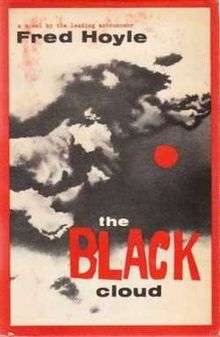The Black Cloud
 Cover of the first edition | |
| Author | Fred Hoyle |
|---|---|
| Cover artist | Desmond Skirrow |
| Language | English |
| Published | 1957 William Heinemann Ltd |
| Media type | Print (book) |
| ISBN | 0-451-11432-9 |
The Black Cloud is a science fiction novel by British astrophysicist Fred Hoyle. Published in 1957, the book details the arrival of an enormous cloud of gas that enters the solar system and appears about to destroy most of the life on Earth by blocking the Sun's radiation.
Plot summary
In 1964, astrophysicists on Earth become aware of a cloud of gas and dust, initially thought to be a Bok globule, that is heading for the solar system. The cloud, if interposed between the Sun and the Earth, could wipe out most of the life on Earth by blocking solar radiation and ending photosynthesis. A cadre of astronomers and other scientists is drawn together in Nortonstowe, England, to study the cloud and report to the British government about the consequences of its presence.
The cloud unexpectedly decelerates as it approaches and comes to rest around the Sun, causing disastrous climatic changes on Earth and immense mortality and suffering for the human race. As the behaviour of the cloud proves to be impossible to predict scientifically, the team at Nortonstowe eventually come to the conclusion that it might be a life-form with a degree of intelligence. The scientists try to communicate with the cloud, and succeed. The cloud is revealed to be an alien gaseous superorganism, many times more intelligent than humans, which is surprised to find intelligent life-forms on a solid planet. It reconfigures itself to allow sunlight to return to the Earth and humanity is saved.
Though its ill-effects on humanity have ceased, several governments are mistrustful of the cloud and prepare a nuclear attack upon it. When the scientists alert the cloud of this plot, it turns the missiles back upon their senders but does not otherwise retaliate. When the astronomers ask the cloud how its lifeform originated, it replies that they have always existed. One of the characters suggests this is incompatible with the Big Bang theory.
The cloud announces that another nearby (by the cloud's standards) intelligent cloud has suddenly stopped communicating and may have vanished. This has apparently happened many times before and is a long-standing mystery to the clouds; the cloud therefore decides to leave the Solar System to investigate. During their last few days of communication two of the scientists try to learn some of the cloud's vast store of knowledge through visual signals, in order to gain further insights about the Universe. Both of them die in the attempt.
Reception
The Spectator described it as "delightful and fascinating," despite the "slightly chilling" implication of the scientists' attitude to the victims.[1] Galaxy reviewer Floyd C. Gale stated that he had not expected "such a noted cosmological theorist" as Hoyle to be a fiction writer but praised the novel "for the high quality of the narrative." Gale stated that "[w]ith the utmost of apparent ease, Hoyle writes a brand of humor that eludes the pens of pros," and hoped that he would "write more superior fictional ventures like this."[2] Damon Knight described Hoyle's plotting as "masterly," saying the novel was "more elaborately convincing and a lot livelier than the usual gloom-laden treatment" in similar stories.[3] Richard Dawkins (writing in the 2010 Penguin Classics reissue) claimed the novel was "one of the greatest science fiction novels ever written."[4]
Scientific background
Though the presence of a sentient cloud of gas may seem unlikely, the story is grounded in hard science.[5] The detection of the cloud is described using physics equations, all of which are included in the book. Hoyle brought his experience and knowledge as the Director of the Institute of Astronomy, Cambridge, a Fellow of the Royal Society into the book. Hoyle was also responsible for the term "Big Bang", though Hoyle himself did not subscribe to the Big Bang theory in favour of his own Steady State Theory.
In a plot twist that foreshadows Hoyle's stance on panspermia, the cloud expresses surprise that intelligent life is capable of forming on planets.
The novel has a recurrent theme of the duplicity and shallowness of politicians compared with scientists.
Notes
- ↑ "New Novels". The Spectator. 4 October 1957. p. 456. Retrieved 2014-03-17.
- ↑ "Galaxy's 5 Star Shelf", Galaxy Science Fiction, December 1958, p.100
- ↑ "In the Balance". If. December 1958, pp.109-10
- ↑ Brandon Robshaw (November 21, 2010). "The Black Cloud, By Fred Hoyle". The Independent.
- ↑ From plasma crystals and helical structures towards inorganic living matter. Institute of Physics. Retrieved on 2007-08-16